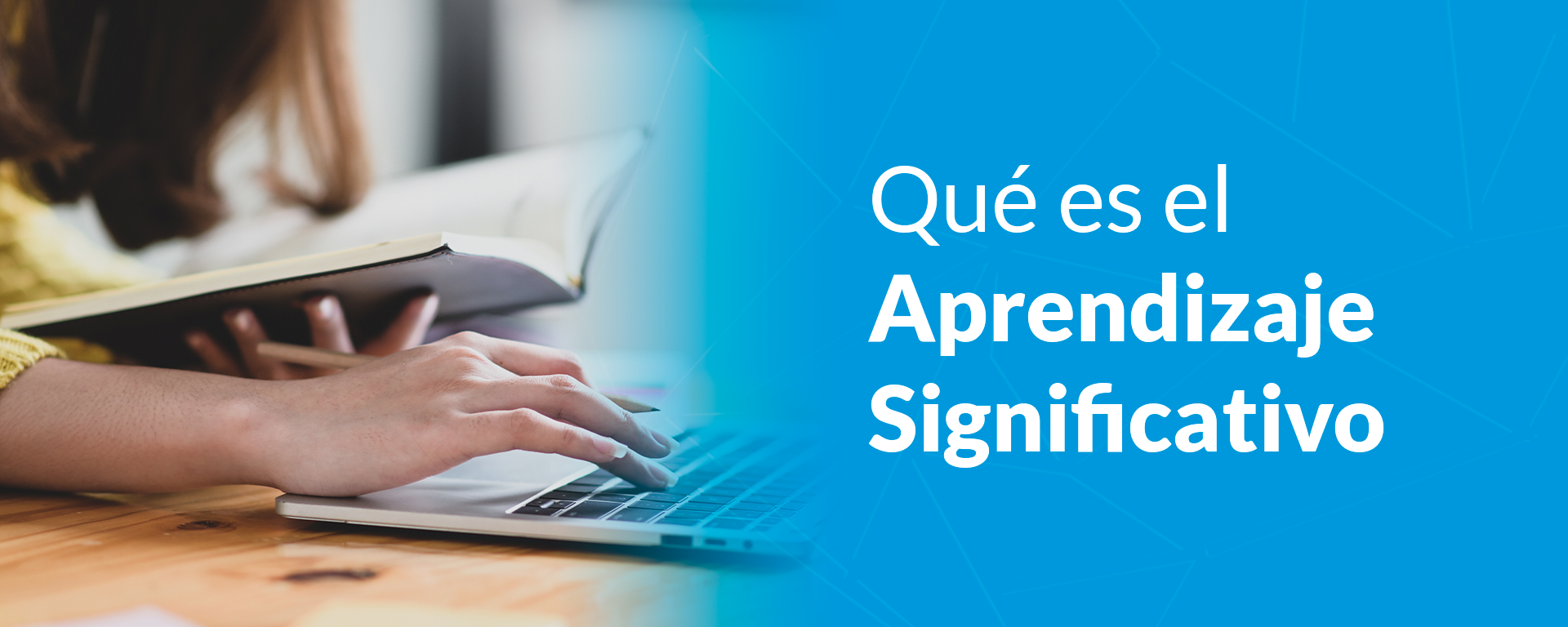
What is meaningful learning?
Meaningful learning is a process that encompasses the emotional, motivational and cognitive dimension of the person. In this type of learning, the student uses their previous knowledge to acquire new one. This process occurs when new content relates to our lived experiences and other knowledge acquired over time. Personal motivation and beliefs about what is important to learn play a very relevant role in this process.
In this learning, how previous skills and knowledge are associated and how new information is integrated into them is influenced by the motivation and meaning attributed to what is learned. This knowledge building process is the key that makes the difference between different forms of learning.
Ausubel's meaningful learning theory
To understand what meaningful learning is, it is necessary to talk about Ausubel’s theory of meaningful learning. The American psychologist and pedagogue proposed a type of learning with the aim of understanding those mechanisms involved in the acquisition and retention of students’ knowledge. According to this theory, the student actually learns when he relates the new knowledge acquired with the knowledge he already possesses.
Thus, Ausubel's theory of meaningful learning states that student learning depends on the connection of new information with the cognitive structure, understanding the cognitive structure as the set of concepts and ideas available to the student.
Ausubel también estableció los principios de diferenciación progresiva y reconciliación integradora. El primero se refiere a que el aprendizaje debe ir de conceptos generales a conceptos más específicos de forma gradual. El segundo implica relacionar e integrar los nuevos conocimientos con los existentes en la estructura cognitiva, modificando y enriqueciendo ambos en el proceso.
Characteristics of meaningful learning
Meaningful learning is based on a constructivist methodology that advocates that students learn beyond memorization. It suits a number of specific characteristics, such as the relationship between the new knowledge with the ones already possessed by the student, the readjustment and enrichment of the previous knowledge, the substantial understanding of the new information provided by the teacher, and the application of the knowledge in different contexts. In addition, it requires active participation by the student.
El proceso de atribuir un sentido personal a lo que se aprende pasa por una dimensión más afectiva y emocional que el aprendizaje «técnico» de una materia. En lugar de simplemente memorizar información para luego reproducirla, como en una respuesta de examen, la finalidad es darle un sentido personal al conocimiento, de poder explicarlo con tus propias palabras e incluso crear nuevo conocimiento a través de este. La diferencia entre el aprendizaje significativo y un aprendizaje repetitivo se remite a la relación, o no, del material a aprender con el conocimiento previo.
Meaningful learning conditions
According to Ausubel, three essential conditions for meaningful learning are required: a non-arbitrary and substantial relationship between the learning material and the student’s prior knowledge, a coherent and organized learning material, and motivation on the part of the student.
- Non-arbitrary and substantial relationship: the learning material must be associated in a non-arbitrary and substantial way (what is acquired is the substance of the new knowledge and new ideas, not the words used to express them) with the knowledge that the student already possesses in his cognitive structure.
- Logical meaning: the learning material must be coherent and organized.
- Psychological meaning: the learning material has become new and distinctive knowledge for the learner.
- Motivation: la motivación del estudiante es imprescindible para conseguir el aprendizaje significativo. Por lo que es importante que el estudiante muestre interés o disposición para aprender. La motivación del estudiante es imprescindible para conseguir el aprendizaje significativo. El interés por aprender facilita que el alumno relacione activamente el nuevo conocimiento con sus saberes previos. La motivación también mejora la retención a largo plazo de lo aprendido. El docente debe despertar la motivación intrínseca en sus alumnos a través de contenidos significativos y estrategias didácticas estimulantes.
For learning to be meaningful, two conditions must be met: logical significance and psychological significance. The first addresses that knowledge must be relevant and having a clear organization. The second implies that there must exist within the cognitive structure the relevant and relatable elements with learning material, as well as a favorable disposition in order to learn the new material and relate it to what you already know.

Benefits of meaningful learning
Ausubel's meaningful learning presents several benefits for today's education, in which a necessary change and evolution in learning methods emerges that allow going beyond memorization.
Down below are mentioned the benefits of meaningful learning:
- The acquisition of new knowledge is promoted because it is linked to knowledge that the student already possesses.
- Knowledges are stored in long-term memory, so the retention of information is long-lasting and persistent.
- It encourages the active participation of the student, since it requires a predisposition to carry out this type of learning.
- The student's motivation to acquire new knowledge increases. These are cause and the effect of this type of learning.
- It is a personalized type of learning, since the acquisition of new knowledge depends on their own knowledge.
Artificial intelligence and active methodologies in meaningful learning
In today’s educational landscape, artificial intelligence (AI) and active learning methodologies are becoming key components. Trends suggest that these elements may play a vital role in improving meaningful learning processes.
Artificial intelligence has the potential to personalize learning in a way not seen before. AI systems can tailor educational content to each student’s individual needs, providing a customized learning path that considers the student’s prior knowledge and learning styles. This is in line with Ausubel’s principle of meaningful learning, which holds that new knowledge is acquired and retained more effectively when it can be related to what the student already knows.
Active learning methodologies, on the other hand, encourage direct student participation in their learning process, allowing them to build their knowledge through direct experience and reflection. This approach can facilitate meaningful learning by promoting a deep understanding of the concepts and application of knowledge in various contexts.
In this sense, the intersection of AI with active methodologies can offer a powerful tool to improve meaningful learning. For example, AI-based learning platforms can provide challenge-based learning scenarios, where students actively apply their knowledge to solve real problems, supplying deeper and longer-lasting learning.
Example of meaningful learning: Challenge-Based Learning (CBL)
A methodology that provides meaningful learning is Challenge Based Learning (CBL). Through this learning method, students learn to know how to do at the same time as putting their skills into practice and solving real problems in which they will have to learn new knowledge.
Emerging technologies are facilitating the implementation of Challenge Based Learning in innovative ways. One of those platforms is BeChallenge methodology, which enables educators to design challenge-based learning experiences that promote meaningful learning.
These BeChallenge methodology features facilitate active learning and experience-based learning, key elements for meaningful learning. By focusing on the student and enabling a practical application of knowledge BeChallenge methodology puede ayudar a facilitar un aprendizaje más profundo y duradero. Para activar los conocimientos previos, el docente puede utilizar estrategias como: lluvia de ideas, preguntas exploratorias, analogías, mapas conceptuales, ejemplos y contraejemplos, entre otras. De esta manera se prepara el terreno en la mente del estudiante para anclar los nuevos contenidos que se desarrollan a lo largo de la experiencia de aprendizaje donde el contenido es totalmente necesario para resolver ese reto planteado.

Learn more about meaningful learning:
- Ausubel, D. (1983). Meaningful learning theory. CEIF Fascicles,, 1(1-10), 1-10. Read article
- Ausubel, D., Novak, J. Y. H. H., & Hanesian, H. (1976). Meaning and meaningful learning. Psicología educativa: un punto de vista cognoscitivo, 1(2), 53-106. Read article
- Moreira, M. A., Caballero, M. C., & Rodríguez, M. L. (1997). Meaningful learning: an underlying concept. Actas del encuentro internacional sobre el aprendizaje significativo, 19(44), 1-16. Read article
- Palmero, M. L. R. (2004). The theory of meaningful learning. In Proceedings of the First International Conference on Concept Mapping (Vol. 1, pp. 535-544). Read article
- Soria, M., Giménez, I., Fanlo, A. J., & Escanero, J. F. (2007). El mapa conceptual: una nueva herramienta de trabajo. Diseño de una práctica para fisiología. Educational Research. Zaragoza: University of Zaragoza. Read article
¿Quieres transformar el aprendizaje en tu institución?
Solicita una demo gratuita y descubre cómo BeChallenge te acompaña en el proceso.
Solicita una demo gratuita

Excelente información, de gran ayuda
Articulo interesante, claro y conciso, fácilmente comprensible. felicitaciones
ME EMOCIONA SABER DE ESTA METODOLOGÍA (ABR), PORQUE ME IDENTIFICO CON LA INFORMACIÓN QUE USTEDES COMPARTEN. YO SOY DOCENTE EN LA ESPECIALIDAD DE MATEMÁTICAS Y PROMUEVO CON MIS ALUMNOS RETOS Y DESAFÍOS. ESTOY EN EL PROCESO DE TERMINAR UN LIBRO QUE SE VA A LLAMAR «PIENSA». GRACIAS POR ESTA INFORMACIÓN
Ojala te vaya bien en ese libro, me encataría leerlo. 🙂
Por favor, cuando hayas terminado el libro, por donde darás el aviso ?
Como citar el articulo en Normas Apa7?
Muy bueno, felicitaciones.